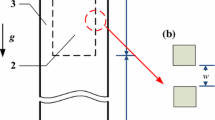Abstract
Recently, our research group proposed the phase separation condenser tube, in which a mesh cylinder was inserted to form the flow structure of “gas near the tube wall and liquid in the tube core”, significantly enhance the condensation heat transfer. But the bubble leakage towards the core region may worsen the heat transfer enhancement. In order to prevent the bubble leakage, the critical criterion was proposed based on the Young–Laplace equation, considering the inertia force, viscous force and pulsating flow. It was found that the critical criterion depends on the dimensionless parameter G *, the We number and a coefficient C. The numerical model was developed in terms of the volume of fluid method to predict the two-phase laminar flow in the phase separation condenser tube. The results show that the bubble leakage takes place at the bubble tip, which is agreed with the experimental observations. The critical curve distinguishing the non-bubble-breaking and bubble-breaking was obtained by comparing the bubble dynamics at different G* and We. The coefficient C was determined. The critical criterion for the bubble leakage is given as \( G^{*} \times We = \left( {0.22We^{0.99349} - \frac{{G^{*} }}{{4.7 \times 10^{3} \times We^{0.00651} }} + \frac{196.39}{{We^{0.00651} }}} \right) \times \frac{{4{ \cos }\alpha }}{\Delta \varTheta W} \), providing the design and operation guidance for the phase separation condenser tube.









Similar content being viewed by others
References
Ma XH, Xu DQ, Lin JF (1999) Condensation heat transfer enhancement with dropwise and film coexisting condensation surface. CIESC J 50:535–540
Zhao Q, Lin JF (1991) Industrial application research progress of dropwise condensation. Chem Ind Eng Progr 42:17–20
Lang XQ, Ma HQ, Tan X (2004) Progress on dropwise condensation mechanismand heat transfer surface modification. J Petrochem Univ 17:32–38
Yang SM, Tao WQ (2006) Heat transfer, 4th edn. Higher education press, Bei**g
Nusselt W (1916) Die Oberflachencondensation Der Wasserdampfes. VDI 60:541–569
Miyara A, Nonaka K, Taniguchi M (2000) Condensation heat transfer and flow pattern inside a herringbone-type micro-fin tube. Int J Refr 23:141–152
Sapali SN, Patil PA (2010) Heat transfer during condensation of HFC-134a and R-404A inside of a horizontal smooth and micro-fin tube. Exp Thermal Fluid Sci 34:1133–1141
Goto M, Inoue N, Yonemoto R (2003) Condensation heat transfer of R410A inside internally grooved horizontal tubes. Int J Refr 26:410–416
Olivier JA, Liebenberg L, Thome JR et al (2007) Heat transfer, pressure drop, and flow pattern recognition during condensation inside smooth, helical micro-fin, and herringbone tubes. Int J Refr 30:609–623
Uchida M, Itoh M, Shikazono N et al (1996) Experimental study on the heat transfer performance of a zeotropic refrigerant mixture in horizontal tubes. International Refrigeration and Air Conditioning Conference, Paper 313
Cavallini A, Del Col D, Doretti L et al (2000) Heat transfer and pressure drop during condensation of refrigerants inside horizontal enhanced tubes. Int J Refr 23:4–25
Muzzio A, Niro A, Arosio S (1998) Heat transfer and pressure drop during evaporation and condensation of R22 inside 9.52 mm O.D. micro-fin tubes of different geometries. Enhanced Heat Transfer 5:39–52
Chen HX, Xu JL, Wang W. An internal condenser tubes dispensing hood. Chinese Patent, 2011, CN102278904A
Chen HX, Xu JL, Wang W. An enhancement condensation pipe with inserted mesh cylinder. USA Patent, 2012, PCT/CN2012/000274
Chen HX, Xu JL, Li ZJ et al (2012) Stratified two-phase flow pattern modulation in a horizontal tube by the mesh pore cylinder surface. Appl Energy 112:1283–1290
Chen HX, Xu JL, Li ZJ et al (2012) Flow pattern modulation in a horizontal tube by the passive phase separation concept. Int J Multiph Flow 45:12–23
Chen HX , Xu JL, **e J et al (2014) Modulated flow patterns for vertical upflow by the phase separation concept. Exper Thermal Fluid Sci 52:297–307
Taha T, Cui ZF (2002) CFD modelling of gas-sparged ultrafiltration in tubular membranes. J Membr Sci 210:13–27
Taha T, Cui ZF (2006) CFD modelling of slug flowin vertical tubes. Chem Eng Sci 61:676–687
Hung T, Lin LW (2002) Active microfluidic mixer and gas bubble filter driven by thermal bubble micropump. Sensor Actuat A 97-98:665–671
Lemenand T, Dupont P, Valle DD et al (2013) Comparative efficiency of shear, elongation and turbulentdroplet breakup mechanisms: Review and application. Chem Eng Res Design 91:2587–2600
Conrath M, Smiyukha YL, Fuhrmann E et al (2003) Double porous screen element for gas–liquid phase separation. Int J Multiph Flow 50:1–15
Federico M, Fernando AM (2012) Multiphase capillary flows. Int J Multiph Flow 42:62–73
Chen QC, Xu JL, Sun DL et al (2013) Numerical simulation of the modulated flow pattern for vertical upflows by the phase separation concept. Int J Multiph Flow 56:105–118
Acknowledgment
This work was supported by the National Natural Science Foundation of China of International Cooperation Project (51210011), the National Basic Research Program of China (2011CB710703), the Young Scientists Fund of the National Natural Science Foundation of China (51106049) and the Fundamental Research Funds for the Central Universities (JB2013144).
Author information
Authors and Affiliations
Corresponding authors
About this article
Cite this article
Chen, Q., Xu, J. & Sun, D. The bubble leakage mechanism for vertical upflows by the phase separation concept. Chin. Sci. Bull. 59, 2638–2646 (2014). https://doi.org/10.1007/s11434-014-0377-4
Received:
Accepted:
Published:
Issue Date:
DOI: https://doi.org/10.1007/s11434-014-0377-4




